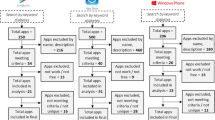Abstract
Given the great potential of mHealth applications as far as chronic diseases management is concerned, we investigated the level of intervention provided by mobile applications for the case of diabetes. Online stores (Google Play Store, App Store, Windows Phone Store) and mHealth-related databases were used as our investigation field and applications were reviewed upon several criteria. Our results indicate that there is still enough room for improvement in order to approach a holistic managemenent point-of-view from an mHealth perspective.
Preview
Unable to display preview. Download preview PDF.
Similar content being viewed by others
References
[1] S. Kumar, W. J. Nilsen, A. Abernethy, A. Atienza, K. Patrick, M. Pavel, W. T. Riley, A. Shar, B. Spring, D. Spruijt-Metz, D. Hedeker, V. Honavar, R. Kravitz, R. Craig Lefebvre, D. C. Mohr, S. A. Murphy, C. Quinn, V. Shusterman, and D. Swendeman, “Mobile Health Technology Evaluation,” Am. J. Prev. Med., vol. 45, no. 2, pp. 228–236, Aug. 2013.
[2] R. Schnall, M. Rojas, S. Bakken, W. Brown, A. Carballo-Dieguez, M. Carry, D. Gelaude, J. P. Mosley, and J. Travers, “A user-centered model for designing consumer mobile health (mHealth) applications (apps),” J. Biomed. Inform., vol. 60, pp. 243–251, Apr. 2016.
[3] C. C. Wilhide Iii, M. M. Peeples, and R. C. Anthony Kouyaté, “Evidence-Based mHealth Chronic Disease Mobile App Intervention Design: Development of a Framework.,” JMIR Res. Protoc., vol. 5, no. 1, p. e25, Feb. 2016.
[4] A. Kadirvelu, S. Sadasivan, and S. H. Ng, “Social support in type II diabetes care: a case of too little, too late.,” Diabetes. Metab. Syndr. Obes., vol. 5, pp. 407–17, 2012.
[5] Y. Wu, X. Yao, G. Vespasiani, A. Nicolucci, Y. Dong, J. Kwong, L. Li, X. Sun, H. Tian, and S. Li, “Mobile App-Based Interventions to Support Diabetes Self-Management: A Systematic Review of Randomized Controlled Trials to Identify Functions Associated with Glycemic Efficacy.,” JMIR mHealth uHealth, vol. 5, no. 3, p. e35, Mar. 2017.
[6] M. Georgsson and N. Staggers, “An evaluation of patients’ experienced usability of a diabetes mHealth system using a multi-method approach,” J. Biomed. Inform., vol. 59, pp. 115–129, Feb. 2016.
[7] M. J. Brooke and A. Rege, “mHealth Technologies in Pre-Diabetes and Diabetes Care,” in Glucose Intake and Utilization in Pre-Diabetes and Diabetes, Elsevier, 2015, pp. 199–214.
[8] F. Fatehi, L. C. Gray, and A. W. Russell, “Mobile Health (mHealth) for Diabetes Care: Opportunities and Challenges,” Diabetes Technol. Ther., vol. 19, no. 1, pp. 1–3, Jan. 2017.
[9] T. Chomutare, L. Fernandez-Luque, E. Arsand, and G. Hartvigsen, “Features of mobile diabetes applications: review of the literature and analysis of current applications compared against evidence-based guidelines.,” J. Med. Internet Res., vol. 13, no. 3, p. e65, Sep. 2011.
[10] S. O. Skrøvseth, E. Årsand, F. Godtliebsen, and R. M. Joakimsen, “Data-Driven Personalized Feedback to Patients with Type 1 Diabetes: A Randomized Trial,” Diabetes Technol. Ther., vol. 17, no. 7, pp. 482–489, Jul. 2015.
[11] J. Tran, R. Tran, and J. R. White, “Smartphone-Based Glucose Monitors and Applications in the Management of Diabetes: An Overview of 10 Salient " Apps " and a Novel Smartphone-Connected Blood Glucose Monitor,” Clin. Diabetes @BULLET, vol. 30, no. 4, 2012.
[12] A. Drincic, P. Prahalad, D. Greenwood, and D. C. Klonoff, “Evidence-based Mobile Medical Applications in Diabetes,” Endocrinol. Metab. Clin. North Am., vol. 45, no. 4, pp. 943–965, Dec. 2016.
[13] International Data Corporation Smartphone OS Market Share Q3. http://www.idc.com/prodserv/smartphone-os-market-share.jsp
[14] M. Alghamdi, H. Gashgari, and M. Househ, “A Systematic Review of Mobile Health Technology Use in Developing Countries.,” Stud. Health Technol. Inform., vol. 213, pp. 223–6, 2015.
[15] A. Beratarrechea, D. Moyano, V. Irazola, and A. Rubinstein, “mhealth Interventions to Counter Noncommunicable Diseases in Developing Countries,” Cardiol. Clin., vol. 35, no. 1, pp. 13–30, Feb. 2017.
Author information
Authors and Affiliations
Corresponding author
Editor information
Editors and Affiliations
Rights and permissions
Copyright information
© 2018 Springer Nature Singapore Pte Ltd.
About this paper
Cite this paper
Zaires, S., Perrakis, G., Bekri, E., Katrakazas, P., Lambrou, G., Koutsouris, D. (2018). Chronic Disease Management via Mobile Apps: The Diabetes Case. In: Eskola, H., Väisänen, O., Viik, J., Hyttinen, J. (eds) EMBEC & NBC 2017. EMBEC NBC 2017 2017. IFMBE Proceedings, vol 65. Springer, Singapore. https://doi.org/10.1007/978-981-10-5122-7_45
Download citation
DOI: https://doi.org/10.1007/978-981-10-5122-7_45
Published:
Publisher Name: Springer, Singapore
Print ISBN: 978-981-10-5121-0
Online ISBN: 978-981-10-5122-7
eBook Packages: EngineeringEngineering (R0)




